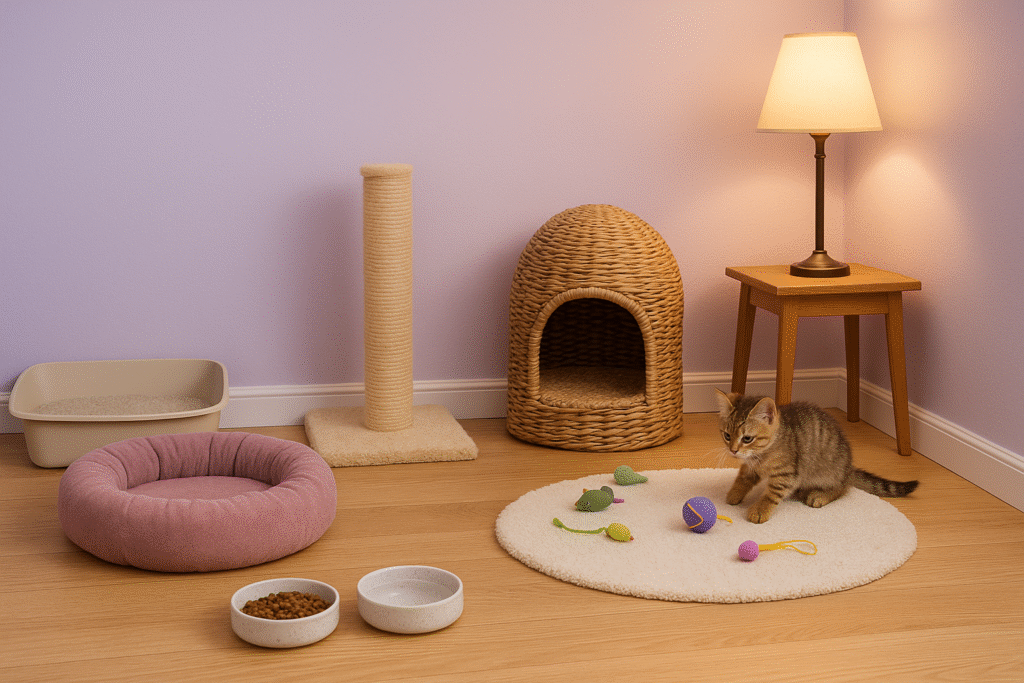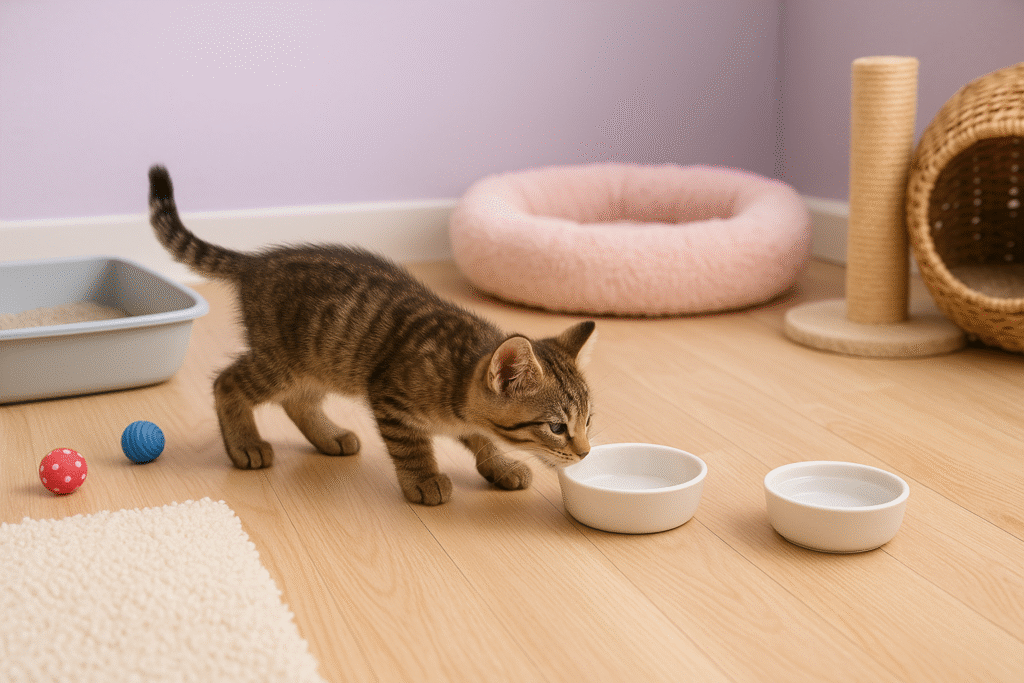Adopting a rescue cat is an exciting, rewarding, yet sometimes challenging journey. Whether you’re bringing home a kitten or an adult cat, the key to a smooth transition lies in careful preparation—both practical and emotional. This comprehensive guide covers every step of preparing for cat adoption, ensuring you create a safe, welcoming space where your new feline friend can thrive.
Before the Cat Arrives – What to Prepare

Set Up a Safe, Quiet Starter Room
Creating a dedicated starter room is crucial to help a new rescue cat adjust. This space serves as a refuge, reducing feelings of overwhelm and stress.
Your starter room should include:
- Litter box with low sides for easy access.
- Food and water bowls, preferably ceramic or stainless steel.
- Comfortable cat bed with soft bedding.
- Toys and scratching post to alleviate boredom.
- Hiding spots such as cardboard boxes or covered beds.
This controlled environment significantly eases your cat’s transition, allowing them to get accustomed to the new surroundings at their own pace.
Essential Supplies Checklist
Prepare these key items before bringing your rescue cat home:
- Food and Water Bowls: Opt for easy-to-clean, sturdy materials.
- Litter Box and Cat Litter: Unscented litter is best initially.
- Cat Bed and Blankets: Provide warmth and comfort.
- Scratching Post: Protects your furniture and helps stress relief.
- Toys: Interactive and safe toys to encourage play.
- Carrier: Secure, comfortable transportation.
- Grooming Kit: Soft brushes, comb, and nail clippers.
- Pheromone Diffuser (e.g., Feliway): Calms nervous cats and reduces anxiety.
Make the House Cat-Proof
Ensure your home is safe and secure by performing a thorough inspection and making necessary adjustments.
- Secure wires and cords to prevent chewing.
- Check windows and doors, using secure screens.
- Remove toxic houseplants (e.g., lilies, aloe vera).
- Eliminate small choking hazards, including rubber bands, yarn, or plastic bags.
Designate safe areas for your cat to explore and clearly define no-go zones with gentle barriers or closed doors.
Prepare Emotionally – What to Expect
Understanding common rescue cat behaviors helps in managing expectations:
- Shyness and fear are typical initially.
- Allow the cat to approach you at their own pace.
- Patience, a calm voice, and consistency build trust.
The First Day – Bringing Your Rescue Cat Home
How to Transport Them Safely
Make your cat’s journey home stress-free:
- Use a secure carrier lined with a soft towel.
- Cover the carrier lightly with a cloth to reduce stimuli.
- Drive calmly, keeping noise levels low.
First Steps Inside Your Home
- Take your cat directly to their quiet starter room.
- Allow them to exit the carrier at their own speed.
- Keep interactions minimal, allowing gentle exploration.
Your Role in the First 24 Hours
- Remain calm, quiet, and available but not intrusive.
- Sit nearby, speak softly, letting them initiate interactions.
- Don’t pressure your new cat to eat or play immediately.
The First Week – Building Trust Gradually

Let Them Lead the Exploration
After initial adjustment:
- Gradually open doors, allowing exploration room-by-room.
- Keep routines consistent—feeding times, sleep schedule.
- Minimize sudden noises or changes.
Feeding, Litter Use, and Sleep Patterns
- Offer small, frequent meals to encourage regular eating.
- Regularly monitor litter usage to identify any health concerns.
- Understand it’s normal for cats to sleep extensively, especially in new environments.
Play, Stimulation, and Interaction
- Use gentle toys like wand toys, balls, or puzzle feeders.
- Avoid overwhelming your cat; start slowly.
- Talk gently, using their name frequently.
Long-Term Integration & Bonding
Introducing Other Pets
Follow these careful steps:
- Begin with scent swapping—exchange blankets or toys.
- Use a barrier or gate initially to maintain safe interactions.
- Monitor closely; never rush introductions.
Vet Visit & Medical Checks
- Schedule a veterinary checkup within the first week.
- Review vaccination history, perform a general health assessment, and confirm microchip details.
- Keep all documents neatly filed.
Establishing Routine
Cats thrive on predictability:
- Feed meals at consistent times.
- Clean the litter box daily.
- Schedule regular playtimes each day.
Rescue-Specific Challenges & Tips
Common Behaviors of Rescue Cats
Common rescue cat behaviors may include:
- Hiding or cautiousness
- Food guarding or resource protection
- Flinching from previous trauma
Combat these with patience, consistency, and calm, predictable behavior from all household members.
How to Build Long-Term Trust
- Avoid direct eye contact initially, use side glances.
- Reward small brave acts with treats.
- Sit quietly in their presence, gently reading or speaking aloud.
Signs of Comfort Over Time
Look for signs that indicate your cat feels safe and comfortable:
- Kneading, purring, or head-bumping.
- Sleeping stretched out rather than curled defensively.
- Following you around or seeking your company actively.
Helpful Internal Resources to Explore
- How to Help Your Kitten Adjust to a New Home
- How to Treat Your Kitten in the First Three Months
- Understanding Kittenhood: Development & Behavior
- Litter Box Training
- Why Is My Cat Meowing So Much?
Quick Tips Box
- Keep the carrier out and accessible for familiarity.
- Talk softly and avoid direct staring.
- Reward small steps like approaching you or eating nearby.
FAQ (Schema-Ready)

Should I let a rescue cat roam the house on day one?
No—initially limit them to one quiet room to avoid overwhelming them.
How long does it take a rescue cat to adjust?
Adjustment varies but typically takes a few days to several weeks. Patience is key.
What if my adopted cat won’t eat or come out?
Give them time. Place food near hiding spots and remain calm and reassuring.
By following this guide, you’ll have a clear plan on how to prepare your home for a rescue cat, ensuring a smooth transition and setting the foundation for a lasting, loving bond. Remember, patience, gentle guidance, and consistency will ultimately win your new cat’s trust and love.
